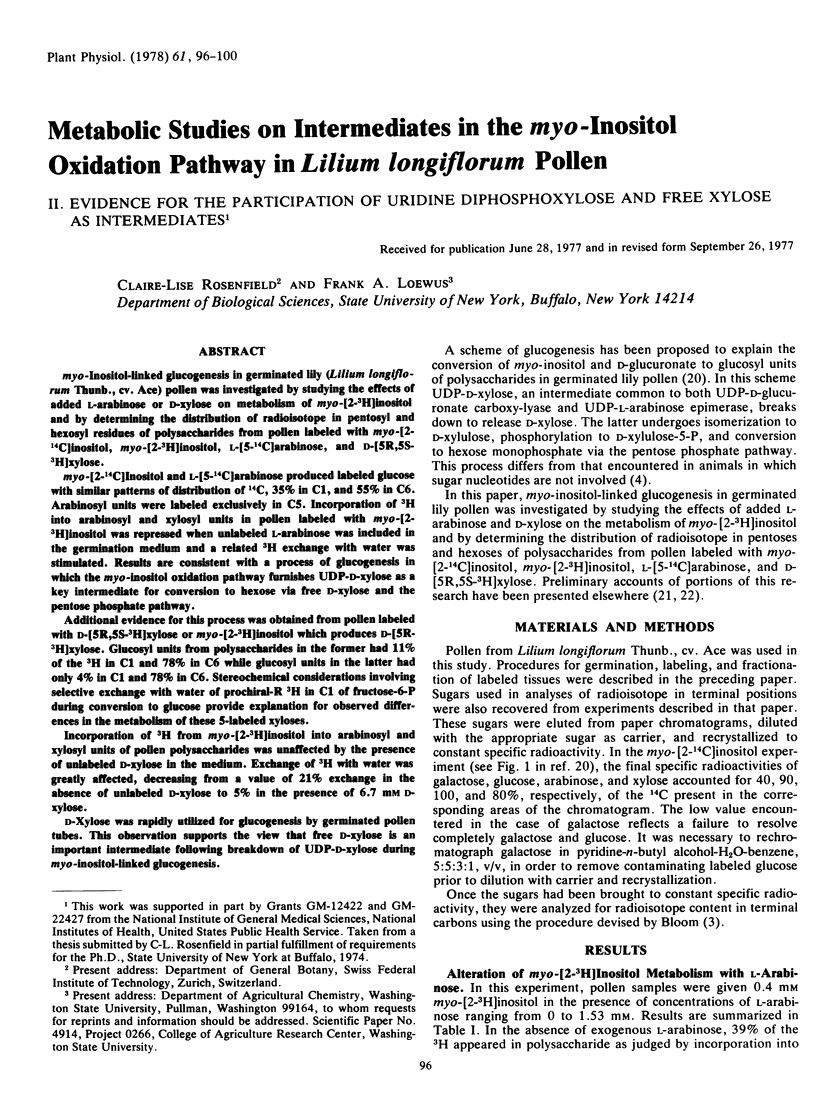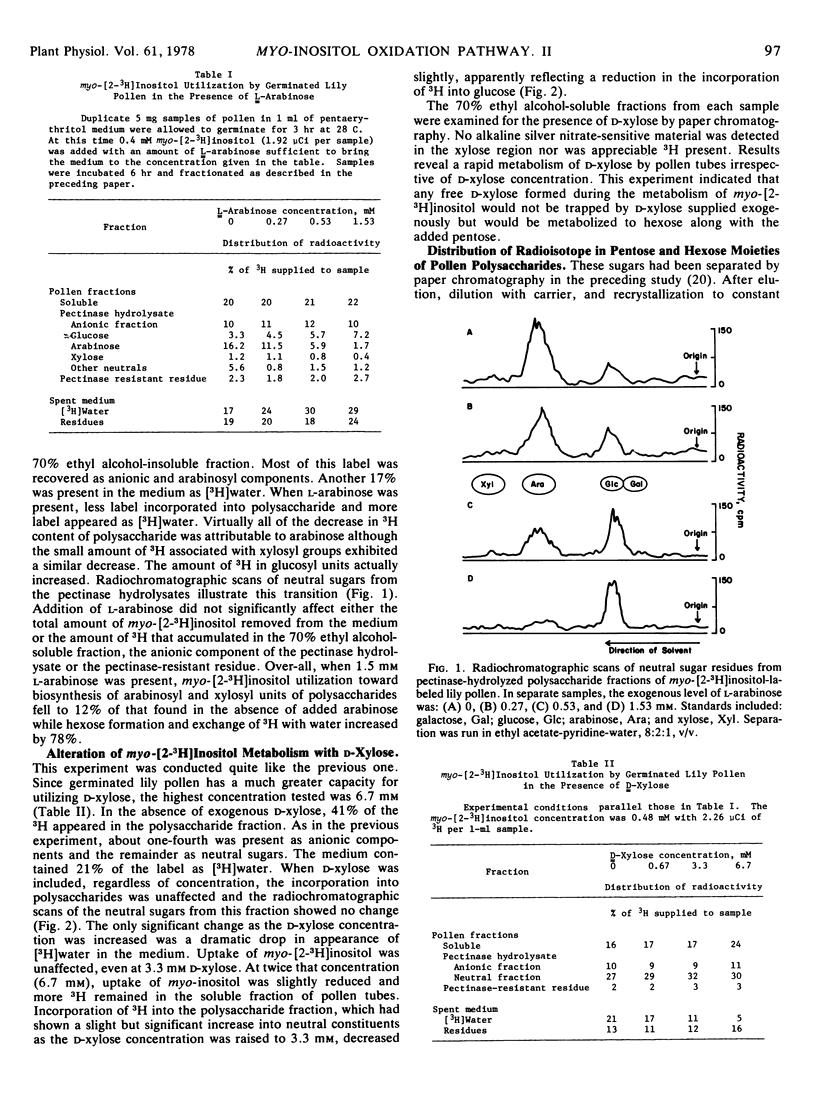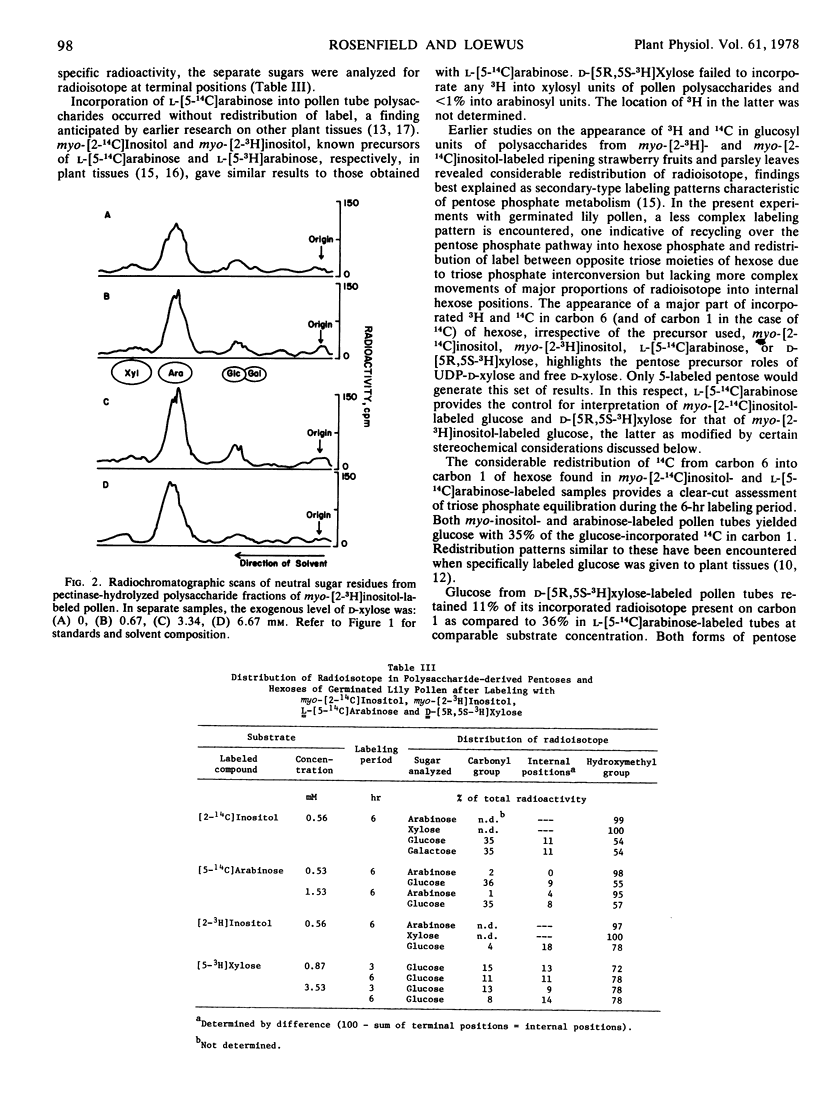Abstract
myo-Inositol-linked glucogenesis in germinated lily (Lilium longiflorum Thunb., cv. Ace) pollen was investigated by studying the effects of added l-arabinose or d-xylose on metabolism of myo-[2-3H]inositol and by determining the distribution of radioisotope in pentosyl and hexosyl residues of polysaccharides from pollen labeled with myo-[2-14C]inositol, myo-[2-3H]inositol, l-[5-14C]arabinose, and d-[5R,5S-3H]xylose.
myo-[2-14C]Inositol and l-[5-14C]arabinose produced labeled glucose with similar patterns of distribution of 14C, 35% in C1, and 55% in C6. Arabinosyl units were labeled exclusively in C5. Incorporation of 3H into arabinosyl and xylosyl units in pollen labeled with myo-[2-3H]inositol was repressed when unlabeled l-arabinose was included in the germination medium and a related 3H exchange with water was stimulated. Results are consistent with a process of glucogenesis in which the myo-inositol oxidation pathway furnishes UDP-d-xylose as a key intermediate for conversion to hexose via free d-xylose and the pentose phosphate pathway.
Additional evidence for this process was obtained from pollen labeled with d-[5R,5S-3H]xylose or myo-[2-3H]inositol which produces d-[5R-3H]xylose. Glucosyl units from polysaccharides in the former had 11% of the 3H in C1 and 78% in C6 while glucosyl units in the latter had only 4% in C1 and 78% in C6. Stereochemical considerations involving selective exchange with water of prochiral-R 3H in C1 of fructose-6-P during conversion to glucose provide explanation for observed differences in the metabolism of these 5-labeled xyloses.
Incorporation of 3H from myo-[2-3H]inositol into arabinosyl and xylosyl units of pollen polysaccharides was unaffected by the presence of unlabeled d-xylose in the medium. Exchange of 3H with water was greatly affected, decreasing from a value of 21% exchange in the absence of unlabeled d-xylose to 5% in the presence of 6.7 mm d-xylose.
d-Xylose was rapidly utilized for glucogenesis by germinated pollen tubes. This observation supports the view that free d-xylose is an important intermediate following breakdown of UDP-d-xylose during myo-inositol-linked glucogenesis.
Full text
PDF




Selected References
These references are in PubMed. This may not be the complete list of references from this article.
- ALTERMATT H. A., NEISH A. C. The biosynthesis of cell wall carbohydrates. III. Further studies on formation of cellulose and xylan from labeled monosaccharides in wheat plants. Can J Biochem Physiol. 1956 May;34(3):405–413. [PubMed] [Google Scholar]
- BLOOM B. The simultaneous determination of C14 and H3 in the terminal groups of glucose. Anal Biochem. 1962 Jan;3:85–87. doi: 10.1016/0003-2697(62)90048-9. [DOI] [PubMed] [Google Scholar]
- BURNS J. J., TROUSOF N., EVANS C., PAPADOPOULOS N., AGRANOFF B. W. Conversion of myo-inositol to D-glucuronic acid and L-gulonic acid in the rat. Biochim Biophys Acta. 1959 May;33(1):215–219. doi: 10.1016/0006-3002(59)90516-5. [DOI] [PubMed] [Google Scholar]
- CHAROLLAIS E., POSTERNAK T. RECHERCHES SUR LA BIOCHIMIE DES CYCLITOLS. IX. CONTRIBUTION 'A L''ETUDE DU M'ETABOLISME DU MS-INOSITOL CHEZ LE RAT. II. Helv Chim Acta. 1965 Jan 2;48:280–284. doi: 10.1002/hlca.19650480128. [DOI] [PubMed] [Google Scholar]
- Ecklund P. R., Moore T. C. Correlations of Growth Rate and De-etiolation with Rate of Ent-Kaurene Biosynthesis in Pea (Pisum sativum L.). Plant Physiol. 1974 Jan;53(1):5–10. doi: 10.1104/pp.53.1.5. [DOI] [PMC free article] [PubMed] [Google Scholar]
- FINKLE B. J., KELLY S., LOEWUS F. A. Metabolism of d-[I-14C]- and d-[6-14C] glucuronolactone by the ripening strawberry. Biochim Biophys Acta. 1960 Feb 26;38:332–339. doi: 10.1016/0006-3002(60)91249-x. [DOI] [PubMed] [Google Scholar]
- GIBBS M., HORECKER B. L. The mechanism of pentose phosphate conversion to hexose monophosphate. II. With pea leaf and pea root preparations. J Biol Chem. 1954 Jun;208(2):813–820. [PubMed] [Google Scholar]
- Hankes L. V., Politzer W. M., Touster O., Anderson L. Myo-inositol catabolism in human pentosurics: the predominant role of the glucuronate-xylulose-pentose phosphate pathway. Ann N Y Acad Sci. 1969 Oct 17;165(2):564–576. [PubMed] [Google Scholar]
- LOEWUS F. A. INOSITOL METABOLISM IN PLANTS. II. THE ABSOLUTE CONFIGURATION OF D-XYLOSE-5-T DERIVED METABOLICALLY FROM MYO-INOSITOL-2-T IN THE RIPENING STRAWBERRY. Arch Biochem Biophys. 1964 Jun;105:590–598. doi: 10.1016/0003-9861(64)90055-4. [DOI] [PubMed] [Google Scholar]
- LOEWUS F. A., JANG R. The conversion of C14-labeled sugars to L-ascorbic acid in ripening strawberries. III. Labeling patterns from berries administered pentose-1-C14. J Biol Chem. 1958 May;232(1):521–532. [PubMed] [Google Scholar]
- LOEWUS F. A., KELLY S. The metabolism of p-galacturonic acid and its methyl ester in the detached ripening strawberry. Arch Biochem Biophys. 1961 Dec;95:483–493. doi: 10.1016/0003-9861(61)90180-1. [DOI] [PubMed] [Google Scholar]
- Loewus F. A., Kelly S., Neufeld E. F. METABOLISM OF MYO-INOSITOL IN PLANTS: CONVERSION TO PECTIN, HEMICELLULOSE, D-XYLOSE, AND SUGAR ACIDS. Proc Natl Acad Sci U S A. 1962 Mar;48(3):421–425. doi: 10.1073/pnas.48.3.421. [DOI] [PMC free article] [PubMed] [Google Scholar]
- Loewus F. Inositol metabolism and cell wall formation in plants. Fed Proc. 1965 Jul-Aug;24(4):855–862. [PubMed] [Google Scholar]
- NEISH A. C. The biosynthesis of cell wall carbohydrates. IV. Further studies on cellulose and xylan in wheat. Can J Biochem Physiol. 1958 Feb;36(2):187–193. [PubMed] [Google Scholar]
- Rosenfield C. L., Fann C., Loewus F. A. Metabolic Studies on Intermediates in the myo-Inositol Oxidation Pathway in Lilium longiflorum Pollen: I. Conversion to Hexoses. Plant Physiol. 1978 Jan;61(1):89–95. doi: 10.1104/pp.61.1.89. [DOI] [PMC free article] [PubMed] [Google Scholar]
- SHIBKO S., EDELMAN J. Randomization of the carbon atoms in glucose and fructose during their metabolism in barley seedlings. Biochim Biophys Acta. 1957 Sep;25(3):642–643. doi: 10.1016/0006-3002(57)90539-5. [DOI] [PubMed] [Google Scholar]


